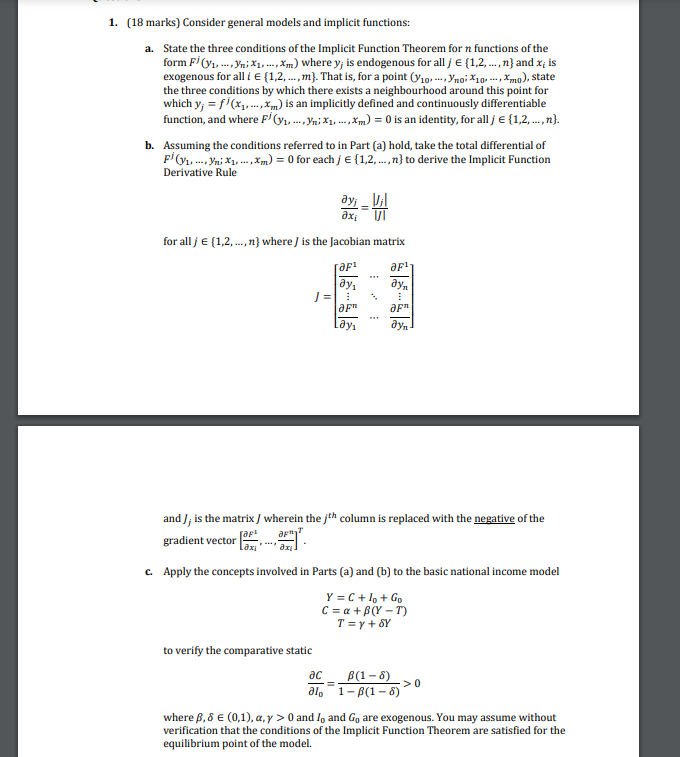
a. State the three conditions of the Implicit Function Theorem for n functions of the form Fj(y1,,yn;x1,,xm) where yj is endogenous for all j{1,2,,n} and xi is exogenous for all i{1,2,,m}. That is, for a point (y10,,yn0;x10,,xm0), state the three conditions by which there exists a neighbourhood around this point for which yj=fj(x1,,xm) is an implicitly defined and continuously differentiable function, and where Fj(y1,,yn;x1,,xm)=0 is an identity, for all j{1,2,,n}. b. Assuming the conditions referred to in Part (a) hold, take the total differential of Fj(y1,,yn;x1,,xm)=0 for each j{1,2,,n} to derive the Implicit Function Derivative Rule xiyj=JJj for all j{1,2,,n} where J is the Jacobian matrix J=y1F1y1FnynF1ynFn and Jj is the matrix J wherein the jth column is replaced with the negative of the gradient vector [xiF1,,xiFn]T. c. Apply the concepts involved in Parts (a) and (b) to the basic national income model Y=C+I0+G0C=+(YT)T=+Y to verify the comparative static I0C=1(1)(1)>0 where ,(0,1),,>0 and I0 and G0 are exogenous. You may assume without verification that the conditions of the Implicit Function Theorem are satisfied for the equilibrium point of the model. a. State the three conditions of the Implicit Function Theorem for n functions of the form Fj(y1,,yn;x1,,xm) where yj is endogenous for all j{1,2,,n} and xi is exogenous for all i{1,2,,m}. That is, for a point (y10,,yn0;x10,,xm0), state the three conditions by which there exists a neighbourhood around this point for which yj=fj(x1,,xm) is an implicitly defined and continuously differentiable function, and where Fj(y1,,yn;x1,,xm)=0 is an identity, for all j{1,2,,n}. b. Assuming the conditions referred to in Part (a) hold, take the total differential of Fj(y1,,yn;x1,,xm)=0 for each j{1,2,,n} to derive the Implicit Function Derivative Rule xiyj=JJj for all j{1,2,,n} where J is the Jacobian matrix J=y1F1y1FnynF1ynFn and Jj is the matrix J wherein the jth column is replaced with the negative of the gradient vector [xiF1,,xiFn]T. c. Apply the concepts involved in Parts (a) and (b) to the basic national income model Y=C+I0+G0C=+(YT)T=+Y to verify the comparative static I0C=1(1)(1)>0 where ,(0,1),,>0 and I0 and G0 are exogenous. You may assume without verification that the conditions of the Implicit Function Theorem are satisfied for the equilibrium point of the model







